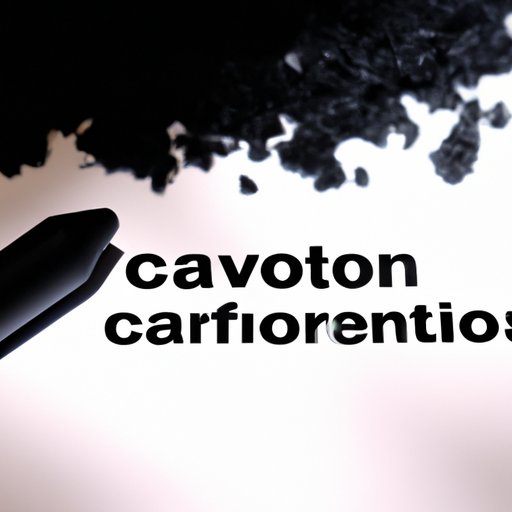Introduction
A primary concern for many in the health and environmental fields is removing impurities and contaminants from our air, water, and other substances. One of the most prevalent methods for achieving this is through the use of activated carbon, a material with remarkable filtration capabilities. But how does activated carbon work to remove impurities and toxins? In this article, we’ll explore the science behind activated carbon, as well as its many uses and benefits.
An Introduction to Activated Carbon: Understanding Its Properties and Uses
Activated carbon, also known as activated charcoal, is a high surface area material produced by heating carbon-rich materials, such as wood, coconut shells, or peat, to extremely high temperatures in the absence of oxygen. This process removes any volatile compounds from the material, leaving behind carbon with a highly porous structure.
Activated carbon has many uses due to its high surface area and porosity. It is commonly used to purify water and air by removing impurities and pollutants, as well as in medicine to treat poisonings and overdoses. It is also used in various industrial processes, such as the production of methane and hydrogen, and even in the purification of gold and other metals.
Unlocking the Science Behind Activated Carbon’s Filtration Capabilities
The science behind activated carbon filtration lies in its unique surface area and pore size. Thanks to its highly porous nature, just one gram of activated carbon can have a surface area of up to 1,000 square meters. These pores are also of varying sizes, which allows for the capture of a broad range of impurities.
Activated carbon works through a process called adsorption, in which impurities are attracted to and trapped on the surface of the carbon. This is due to the carbon’s high surface area which provides a vast amount of space for impurities to cling to. As air or water flows through the activated carbon, impurities such as volatile organic compounds, chlorine, and heavy metals are attracted to its surface and held there, effectively removing them from the substance.
Removing Impurities with Activated Carbon: How It Works in Everyday Life
Activated carbon can be found in a variety of everyday products, including water filters, air purifiers, and aquarium filtration systems. One of its most common uses is in water filtration, where it is used to remove impurities and improve the taste and odor of water. It is also used in air purifiers to remove airborne pollutants and improve indoor air quality.
Activated carbon can remove a variety of impurities, including but not limited to:
- Chlorine
- Volatile Organic Compounds (VOCs)
- Heavy Metals (i.e. lead, mercury, cadmium)
- Trihalomethanes (THMs)
- Herbicides and pesticides
Unraveling the Mysteries of Activated Carbon Adsorption: A Comprehensive Guide
Activated carbon adsorption is the process by which impurities are attracted to and bonded with the carbon’s surface. This process occurs due to the electrostatic attraction between the impurities and the carbon’s surface. The size, shape, and polarity of the molecule plays a role in the adsorption process, as larger molecules are typically more easily trapped on the surface of the carbon.
Factors such as temperature, pH, and contact time play a role in the adsorption process. Generally, the higher the temperature, the greater the adsorption capacity of the activated carbon. The pH of the solution also affects the adsorption process, as certain compounds are more easily adsorbed at a specific pH range. Contact time also plays a role, as longer contact time allows for greater adsorption of impurities.
The Environmental and Health Benefits of Activated Carbon Filtration
Activated carbon filtration can provide numerous environmental and health benefits. One of the primary environmental benefits of activated carbon filtration is reducing pollution and limiting the use of chemicals. Additionally, because activated carbon can remove a range of impurities, it is often used as a first line of defense against harmful contamination in water and air.
From a health standpoint, activated carbon filtration can remove harmful toxins that can lead to a variety of negative health effects, such as respiratory distress, gastrointestinal issues, and even cancer. It can also improve the taste and odor of water and air, making it more palatable and enjoyable to consume.
Bringing Clarity to Activated Carbon: How It Works, Its Benefits, and Limitations
Activated carbon filtration has numerous benefits, including its ability to remove a broad range of impurities from water and air. However, it is important to note that activated carbon has its limitations. For example, it cannot remove all contaminants, such as bacteria and viruses, and must be used in conjunction with other purification methods in some cases.
Despite its limitations, activated carbon remains a highly effective method for purifying water and air, as well as in a variety of industrial and medicinal applications. Understanding how activated carbon works and its many benefits can help individuals and industries make informed decisions about its use.
Conclusion
Activated carbon is a remarkable material with incredible filtration capabilities. Its diverse uses, environmental benefits, and health benefits make it an essential tool for purifying a broad range of substances. Whether you’re looking to purify your water, improve your indoor air quality, or treat a poisoning or overdose, activated carbon can help. By understanding the science behind activated carbon filtration and its many benefits, we can all benefit from this remarkable material in our daily lives.
(Note: Is this article not meeting your expectations? Do you have knowledge or insights to share? Unlock new opportunities and expand your reach by joining our authors team. Click Registration to join us and share your expertise with our readers.)
